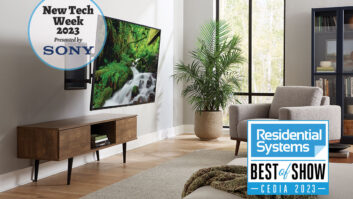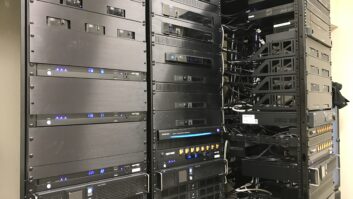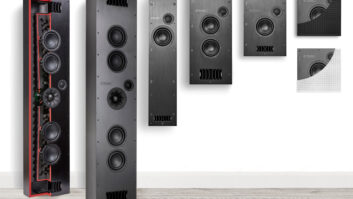
With more and more products and services reliant on the home network, building a robust and secure one — both wired and wireless — is absolutely paramount.
Strong home networks are, for the most part, being driven by two technology segments: convenience-led IoT devices and streaming video.
“Devices like Alexa, Google Home, and Apple HomePod, with all of their connected cloud devices, are driving the charge for a strong wired and wireless network, especially when tied to a home automation system,” explains Joe Whitaker, president, The Thoughtful Home.
“These cloud-based devices, such as Ring for example, require a solid network to be in the ‘always on, always connected’ framework. With streaming video, the trend has finally broken the mold from being mobile-device dominant to an entirely new world of on-screen content. Take my own home, for example. Not having a solid network would cause us to totally miss the news while our son was playing Minecraft on a mobile device!”
The way that people consume media today has certainly undergone a major paradigm shift, with streaming media proliferating the residential landscape. Content from multiple providers is easily accessible anywhere and anytime, and consumers have a wide variety of viewing options, from mobile devices, to displays, TVs, cameras, and more.
“Media is streaming to not just one source, but to many, making a strong home network essential to preclude latency, buffering, and other issues,” says Ed Buday owner, Buday’s Home Electronics Simplified. Indeed, according to the Internet and Television Association, the average number of devices per person is currently eight.
“Nothing beats the performance and reliability of a wired home network, which can be challenging to install into existing homes,” he continues. “Capacity and throughput can make or break the performance and security of a home network. Both elements ensure that signals travel fast and reliably. Moreover, they help future-proof a home network by offering the capability to support additional devices.”
Add other automated systems, cameras, smart locks, climate control — plus doorbells and outdoor cameras, which have “one of the most robust network requirements because of the indoor-to-outdoor transition,” according to Steve Stary, executive vice president at Brilliant AV — and capacity is even more important, particularly when it comes to home security.
“Internet security tends to be a concern of high-value clients,” opines Sean Skelley, CEO and owner of Definitive. “With 4K video all over the property and advanced controls that require ultra-fast response times where latency is seen as a defect — all these things affect network robustness. If people touch a button, they want something to happen!”
A robust and secure home network demands various properties to guarantee effectiveness, including robust, modern firewalls and reliable internet.
“An advanced firewall, an enterprise-grade switch with proper VLAN segmenting, and ultra-fast Wi-Fi connectivity with a high number of simultaneous client device supports is essential,” continues Skelley.
Steve Stary adds, “A professional firewall that is set up properly is a must, along with managed switches to allow configuration of traffic, a non-descript Wi-Fi name with a strong password, and an extremely reliable internet connection: the internet is now a utility like power and water.”
“We have moved way beyond the 60.00 router from Office Max!” exclaims Whitaker. “In today’s home, the mix of wired and wireless devices requires us to treat our homes like small-to-medium-size businesses. The standard mix should be a standalone router, a gig network switch, and separate wireless access points, all run over a minimum of Category 6 wiring.
“As our incoming service-provided internet speeds increase, our in-home infrastructure needs to increase as well. Brands like Pakedge and Luxul, which are my go-to networking brands, allow us to make sure the maximum speeds and bandwidth are available.
“And segmenting the network is one of the most important things to do today. Don’t let guests on your personal Wi-Fi! Create a guest network. They could hog up all the speed, infect other devices on your network, or be the cause of information theft.
“Also create a separate VLan for IoT Cloud devices. Devices like Ring, EcoBee, Nest, Amazon Echo, and Google Home only require internet access; they do not need access to your local devices. Exposing those devices to your local network could potentially expose your mobile, computing, and security devices to the wild world of the dark web!”
Related: Connecting the Smart Home
Wireless Worries
Wireless has certainly created additional challenges to home networks, not just in terms of security, but also capacity. The proliferation of wireless devices — not just from occupants of the household, but guests, too — can eat up a lot of bandwidth, potentially impacting the overall performance of a wireless network.
“Wireless networks are by far the most challenging and the most popular,” says Stary. “As a matter of fact, many clients simply say ‘Wi-Fi’ to represent the entire network and internet!
“Education of clients is therefore essential when delivering a quality wireless network experience. Wi-Fi is a two-way conversation between the installed network and the devices the client is using. The devices have a part to play in a quality experience, but we don’t have direct control. It’s important to get the client to understand what the device’s role is.”
“Wireless has certainly become the buzzword,” adds Whitaker. “We sometimes hear, ‘Can’t it all be wireless?’ Well of course it can, but you do not want the headaches that would come with putting everything on the wireless network. When you can go wired, go wired!”
A wired network will, of course, always be more robust, secure, and efficient than a wireless one. Some devices are more suited to wireless than others, and sometimes wireless is the preferred choice and perhaps the only way to go — such as with the standard Ring doorbell.
“The challenge is that the general public has been brainwashed to believe everything can and should be wireless,” continues Whitaker. “This is not the case. We even have had some clients express shock when telling them a Sonos speaker requires a power outlet and they say, ‘Wait, I thought it was wireless!’” (Of course, the recent launch of the new Sonos Move may put an end to that particular discussion!)
“If you use true enterprise-grade access points, many of the wireless problems are resolved straight away,” explains Skelley. “But you should always wire things that can be wired — which is why we need access to the clients early in the build.”
Hardwired connections will, of course, enhance the performance of any home network. And when using wireless solutions, the use of enterprise-grade equipment — wireless access points, dedicated switches and routers — that can handle heavy network traffic is essential.
“Best practice is to hardwire everything that isn’t portable to keep the wireless network load down,” says Stary. “Also, the use of client-owned modems to ensure that the technology pro has full control over the connection to the ISP and network monitoring systems to allow remote diagnostics for any network issues. Finally, provide easy-to-reset modems and networks to allow maximum uptime and the quickest restoration of internet services in the event of any issues.”
And when it comes to wireless, well-planned and placed wireless access points are key to any solid network. “These devices, which should be in a managed and controlled environment, are key. Pakedge, Luxul, Araknis, and Cisco Meraki all have managed and controlled wireless networks,” says Whitaker.
The importance of a multi-access point configuration is in understanding overlap and coverage. Whitaker explains that the expected client usage of a properly designed and deployed wireless network is the ability to move through an entire property without ever dropping a signal or losing speed: “This is only possible with a well-designed and deployed managed wireless network!”
Nick DeClemente, CEO and founder of Elevated Integration, adds, “The single biggest thing in my mind is picking a platform, committing to learning about how to configure and deal with the nuances of that platform, understanding the best practices and requirements for the other hardware you are putting on that network, use fiber whenever you can, and having a solid power foundation!”
Related: Integration Guide to Networks
Client Concerns
Wired networking is definitely the key to ensuring that the network is robust, and given the preference clients have — understandably — for wireless, one of the biggest challenges is making them appreciate why laying cables is so important, as well as seeing the importance of a decent network setup in the first place.
“The only real challenge in building a solid network is helping the client understand the importance of a solid network,” says Whitaker. “Networks themselves are a science that has been long established, and network best practices and classes can be found for residential deployment at CEDIA.”
Skelley says, “Getting in front of the client before the sheetrock [drywall] is up, so that the home can be properly wired — that’s crucial!”
“Cost, the ability to pull wire into existing homes, and battling DIY brands — these are some of the pinch points and challenges of installing a robust network,” agrees DeClemente.
“While wireless performance has vastly improved, it is more complicated than ever to deliver the promised performance due to RF saturation and not having control of the client-owned devices (i.e., older products),” he says.
Ultimately, building a solid network all comes down to knowledge and education — both for the installer and the client. Whitaker recommends CEDIA’s ESC-N and Control4’s PCNA Certification classes as “the perfect theory and real-life combination of knowledge” to help create solid, stable, and serviceable residential networks.
“Knowing your products, how they work, and the best practices that go along with them, will ensure a happy client — equating to a healthy business,” he adds.
“Meeting with the client to educate them that the network is the foundation of their automated, lighted, entertainment-based home — this is crucial,” says Skelley. “It’s only once they truly understand that we can design and build a proper network for their home, that we will be in a position to ensure the delivery of the best possible solution.”
********************
Based in both London and the south west coast of England, Rob Lane has been writing about residential systems, consumer electronics, and pro AV for 25 years, and has edited a number of consumer-facing UK home theater and CE magazines through the ’90s and ’00s – as well as publishing his own residential systems B2B title for a decade. He started his own PR and marketing support agency in 2009, and continues to run it alongside his numerous writing gigs for leading B2B publications.
Networking Tools
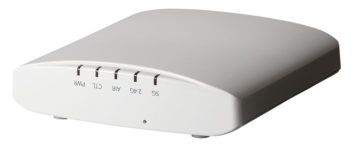
Access Networks A320 Wireless Access Point
The Access Networks A320 entry-level access point delivers 802.11ac Wave 2 wireless networking and features patented BeamFlex adaptive antenna technology that uses multi-directional antenna patterns for performance optimization and interference mitigation. The A320 is available in Standard and Unleashed versions.
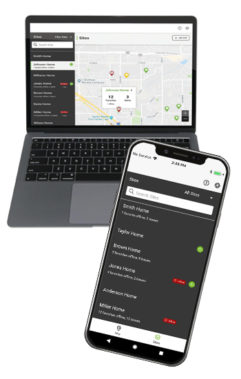
Luxul ProWatch
Luxul’s new ProWatch cloud management solution allows integrators to remotely monitor and manage every device on their clients’ networks, getting real-time notifications of status and quickly resolving issues. With cloud management, integrators can access their customers’ Luxul networks and connected devices at any time — from anywhere — in map or list views via an intuitive web interface. Site-level indicators provide the online/offline status of connected devices and the availability of firmware updates, while customizable alerts notify integrators of issues via text or email. ProWatch will be available March 2020.
Netgear PoE+ Switches
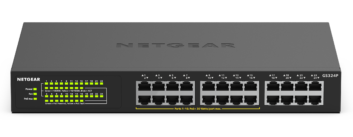 The Netgear GS324P 24-port gigabit Ethernet unmanaged PoE+ switch provides 190W PoE budget across and 16 ports PoE+ with an additional 8 non-PoE ports. The GS324PP 24-port gigabit Ethernet unmanaged high-power PoE+ switch has a 380W PoE power budget across all 24 ports to connect to your existing core network. Netgear’s “PoE Power Auto-Balance and Allocation” PoE technology automatically balances the PoE power allocated to each port based on the device needs independent of PoE class detected, ensuring optimal power allocation and energy efficiency across PoE ports.
The Netgear GS324P 24-port gigabit Ethernet unmanaged PoE+ switch provides 190W PoE budget across and 16 ports PoE+ with an additional 8 non-PoE ports. The GS324PP 24-port gigabit Ethernet unmanaged high-power PoE+ switch has a 380W PoE power budget across all 24 ports to connect to your existing core network. Netgear’s “PoE Power Auto-Balance and Allocation” PoE technology automatically balances the PoE power allocated to each port based on the device needs independent of PoE class detected, ensuring optimal power allocation and energy efficiency across PoE ports.


